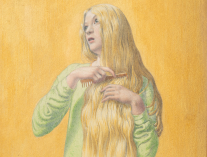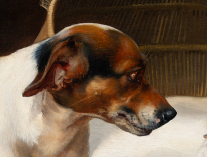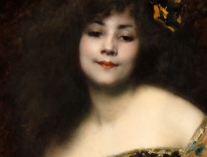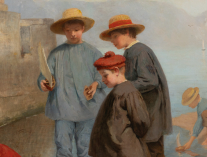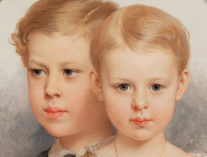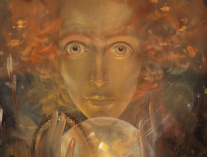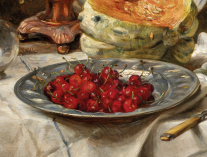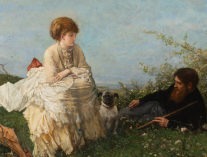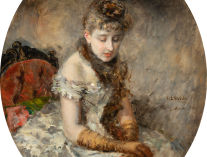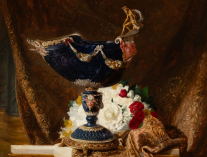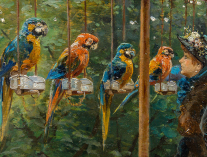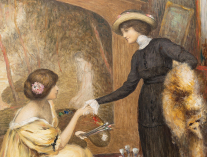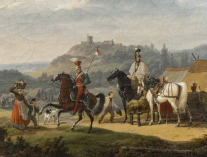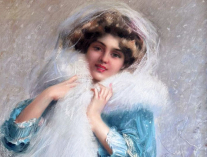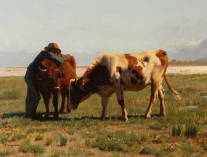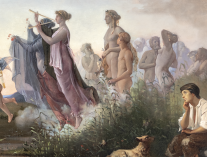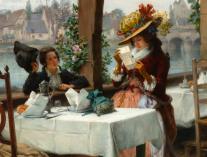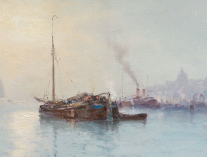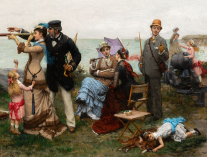Jean-Pierre Laÿs
Good and evil
Oil on canvas signed and dated "JP. Lays 1871" lower right
Good and Evil (Le Bien et le Mal) are represented by good and bad fruits weighed on a scale with the head of a lion surmounting a tomb. The painting metaphorically evokes the Final Judgment by God of all humanity. At the top, on the pediment of the funeral urn, the inscription in red letters on a carved stone book, opera illorum sequuntur illos, is taken from the Apocalypse of St. John the Apostle (Chapter 14, verse 13). The Christ promises to reward the beneficial actions made to others. The angel of the resurrection stands out on the illuminated wall of the tomb. Read more
Among the types of good fruits are the Eucharistic symbols: the grapes for the sacramental wine and the ears of wheat for the sacramental bread. They are painted in the center of the composition among garnets and velvety-skinned peaches. On the lighter platform of the weighing scale, the thistles, the poppies and the spiky husks of the chestnuts - funeral fruits of All Saints’ Day - evoke Purgatory.
On the foreground, the vanquished evil snake shies away from the power of Good reinforced by the presence of immortals, violets and primroses, symbols of eternal life and hope of virtue. The design of the plants and the impeccable design of fruits suggest a long process of development to achieve such dramatic intensity. The variety of colors used testifies to Jean-Pierre Laÿs’ talent as a colourist.
The painting was exhibited at least four times in France and abroad. First in Lyon in 1872, where Alice Souchier admired this « allegory of a painter in love with the ideal » in her review of the Painting Section at the World and International Exhibition. The following year, Le Bien et le Mal was part of the official French selection of contemporary artworks exhibited at the 1873 Vienna World’s Fair. Then the painting was shown at the 1874 Paris Salon where Jean-Pierre Laÿs’ display was duly noted by Louis Gonse the editor-in-chief of the Gazette des Beaux-Arts. Le Bien et le Mal was then considered as a « key work » in the painter's career. The same year, it was exhibited in Avignon at the Salon of the Société des Amis des Arts d’Avignon and in Rouen at the Fine Arts Salon. In 1876, the career of Jean-Pierre Laÿs was flourishing with an international scope. His paintings appeared so far at World’s fairs (in 1851 London, in 1855 Paris and in Geneva). He had received multiple awards at the salons in Lyon, Marseille, Dijon, Troyes, Nîmes and in Bayonne.
At the end of May 1877, the painting was bought by Auguste-Antoine Genin a wealthy connoisseur from Lyon, for the purpose of a donation to the Grenoble Museum. Eleven years later, it was exhibited in Charles Dusserre's Gallery, Place des Terreaux in Lyon. According to Jean-Pierre Laÿs’ biographer, Aimé Vingtrinier, its price was incredibly high and could only tempt one of those happy millionaires who did not know what to do with their fortune such as the painter Jean-François Millet’s works whose paintings were attaining yet staggering prices.
Adèle Souchier, « Une visite à l’exposition Universelle de 1872 », Revue du Lyonnais. Recueil historique et littéraire, 1872, 3e série, Tome 13, p. 242.
Saint-Cyr de Rayssac, « Les Beaux-Arts à l’exposition Lyonnaise », Gazette des Beaux-Arts, July 1st 1872, Tome VI, p. 344.
Exposition universelle de Vienne, 1873. France Œuvres d’art et Manufactures nationales, Paris, 1873, p. 124.
Officieller Kunst-Catalog, Welt-Ausstellung 1873 in Wien, Wien, Verlag der General-Direction 1873, p. 9.
Explication des ouvrages de peinture et dessins, sculpture, architecture et gravure des artistes vivans...Paris, imprimerie nationale, 1874, p. 159.
Louis Gonse, « Salon de 1874. VII. », Gazette des Beaux-Arts, July 1st 1874, Tome X, p.152.
Bepp, « Le Salon de 1874 », Mémorial de la Loire et de la Haute-Loire, 30 May 1874, p. 3.
Livret explicatif des ouvrages de peinture, sculpture, dessins, gravure, etc. Admis à l’exposition de la Société des amis des Arts d’Avignon de 1876, Avignon, 1876, p. 13.
Aimé Vingtrinier, Lays, peintre de fleurs, Lyon, éditeur, H. Georg, 1889, pp. 51-52, p. 68, p. 80.
Catalogue de l’exposition Les peintres de l’âme : art lyonnais du XIXe siècle, Lyon, musée des Beaux-Art, 1981, p. 183, n°90 (esquisse).
André Laÿs, Les Laÿs vus par un Laÿs, 1982, p. 130, p. 145 (catalogue autographe des peintures de Laÿs, H 71: Le Bien et le mal).
Gérard Bonnin, François Lespinasse, Pierre Sánchez, Salons et expositions, Rouen : répertoire des exposants et liste de leurs œuvres, 1833-1947, Dijon, l’Échelle de Jacob, 2010, p. 1078.
Dominique Dumas, Jean-Jacques Lerrant, Salons à Lyon (1919-1945) : catalogue des exposants et liste de leurs œuvres, Dijon, l’Échelle de Jacob, 2010, Tome 1, p. 787.
Estate of the artist
Acquired by Auguste-Antoine Genin in May 1877, for the purpose of a donation to the Grenoble Museum (cf. André Laÿs, Les Laÿs vus par un Laÿs, 1982, p. 130).
Collection of Charles Dusserre (art dealer based in Lyon) in 1888 (cf. Aimé Vingtrinier, Lays, peintre de fleurs, Lyon, H. Georg, 1889, p. 51-52, p. 80).


Our artwork available
93400 Saint-Ouen sur Seine



